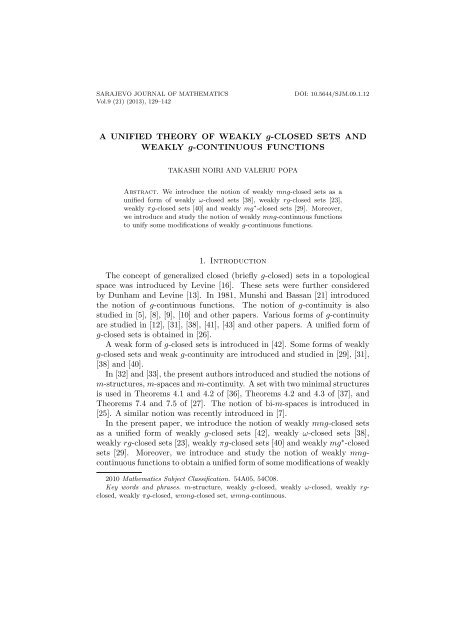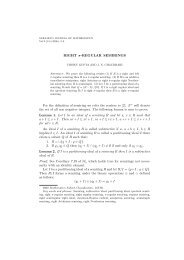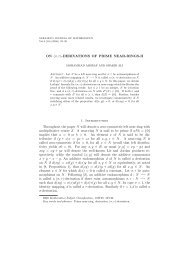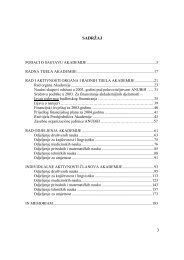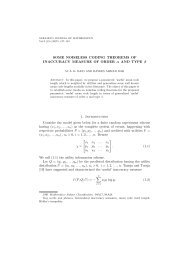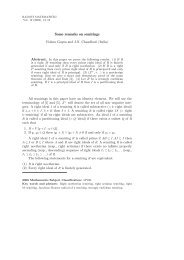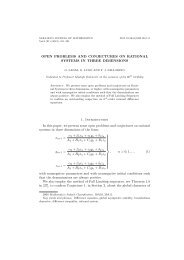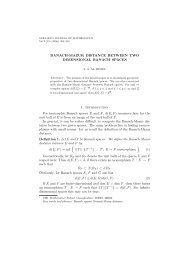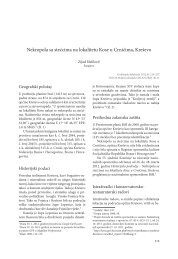Takashi Noiri and Valeriu Popa - anubih
Takashi Noiri and Valeriu Popa - anubih
Takashi Noiri and Valeriu Popa - anubih
Create successful ePaper yourself
Turn your PDF publications into a flip-book with our unique Google optimized e-Paper software.
SARAJEVO JOURNAL OF MATHEMATICSVol.9 (21) (2013), 129–142DOI: 10.5644/SJM.09.1.12A UNIFIED THEORY OF WEAKLY g-CLOSED SETS ANDWEAKLY g-CONTINUOUS FUNCTIONSTAKASHI NOIRI AND VALERIU POPAAbstract. We introduce the notion of weakly mng-closed sets as aunified form of weakly ω-closed sets [38], weakly rg-closed sets [23],weakly πg-closed sets [40] <strong>and</strong> weakly mg ∗ -closed sets [29]. Moreover,we introduce <strong>and</strong> study the notion of weakly mng-continuous functionsto unify some modifications of weakly g-continuous functions.1. IntroductionThe concept of generalized closed (briefly g-closed) sets in a topologicalspace was introduced by Levine [16]. These sets were further consideredby Dunham <strong>and</strong> Levine [13]. In 1981, Munshi <strong>and</strong> Bassan [21] introducedthe notion of g-continuous functions. The notion of g-continuity is alsostudied in [5], [8], [9], [10] <strong>and</strong> other papers. Various forms of g-continuityare studied in [12], [31], [38], [41], [43] <strong>and</strong> other papers. A unified form ofg-closed sets is obtained in [26].A weak form of g-closed sets is introduced in [42]. Some forms of weaklyg-closed sets <strong>and</strong> weak g-continuity are introduced <strong>and</strong> studied in [29], [31],[38] <strong>and</strong> [40].In [32] <strong>and</strong> [33], the present authors introduced <strong>and</strong> studied the notions ofm-structures, m-spaces <strong>and</strong> m-continuity. A set with two minimal structuresis used in Theorems 4.1 <strong>and</strong> 4.2 of [36], Theorems 4.2 <strong>and</strong> 4.3 of [37], <strong>and</strong>Theorems 7.4 <strong>and</strong> 7.5 of [27]. The notion of bi-m-spaces is introduced in[25]. A similar notion was recently introduced in [7].In the present paper, we introduce the notion of weakly mng-closed setsas a unified form of weakly g-closed sets [42], weakly ω-closed sets [38],weakly rg-closed sets [23], weakly πg-closed sets [40] <strong>and</strong> weakly mg ∗ -closedsets [29]. Moreover, we introduce <strong>and</strong> study the notion of weakly mngcontinuousfunctions to obtain a unified form of some modifications of weakly2010 Mathematics Subject Classification. 54A05, 54C08.Key words <strong>and</strong> phrases. m-structure, weakly g-closed, weakly ω-closed, weakly rgclosed,weakly πg-closed, wmng-closed set, wmng-continuous.
130 TAKASHI NOIRI AND VALERIU POPAg-continuous functions. By using m-continuity, we obtain several characterizations<strong>and</strong> properties of weakly mng-continuous functions.2. PreliminariesLet (X, τ) be a topological space <strong>and</strong> A a subset of X. The closure of A<strong>and</strong> the interior of A are denoted by Cl(A) <strong>and</strong> Int(A), respectively. A subsetA is said to be regular open if A = Int(Cl(A)). We recall some generalizedopen sets in a topological space.Definition 2.1. Let (X, τ) be a topological space. A subset A of X is saidto be(1) α-open [24] if A ⊂ Int(Cl(Int(A))),(2) semi-open [15] if A ⊂ Cl(Int(A)),(3) preopen [18] if A ⊂ Int(Cl(A)),(4) β-open [1] or semi-preopen [3] if A ⊂ Cl(Int(Cl(A))),(5) b-open [4] if A ⊂ Int(Cl(A)) ∪ Cl(Int(A)),(6) π-open [45] if A is the finite union of regular open sets.The family of all α-open (resp. semi-open, preopen, b-open, β-open, π-open, regular open) sets in (X, τ) is denoted by α(X) (resp. SO(X), PO(X),BO(X), β(X), π(X), RO(X)).Definition 2.2. Let (X, τ) be a topological space. A subset A of X issaid to be α-closed [19] (resp. semi-closed [11], preclosed [18], b-closed [4],β-closed [1], π-closed) if the complement of A is α-open (resp. semi-open,preopen, b-open, β-open, π-open).Definition 2.3. Let (X, τ) be a topological space <strong>and</strong> A a subset of X. Theintersection of all α-closed (resp. semi-closed, preclosed, b-closed, β-closed,π-closed) sets of X containing A is called the α-closure [19] (resp. semiclosure[11], preclosure [14], b-closure [4], β-closure [2], π-closure) of A <strong>and</strong>is denoted by αCl(A) (resp. sCl(A), pCl(A), bCl(A), β Cl(A), πCl(A)).Definition 2.4. Let (X, τ) be a topological space <strong>and</strong> A a subset of X. Theunion of all α-open (resp. semi-open, preopen, b-open, β-open, π-open) setsof X contained in A is called the α-interior [19] (resp. semi-interior [11],preinterior [14], b-interior [4], β-interior [2], π-interior) of A <strong>and</strong> is denotedby αInt(A) (resp. sInt(A), pInt(A), bInt(A), β Int(A), πInt(A)).3. Minimal structures <strong>and</strong> m-continuityDefinition 3.1. Let X be a nonempty set <strong>and</strong> P(X) the power set of X.A subfamily m X of P(X) is called a minimal structure (briefly m-structure)on X [32], [33] if ∅ ∈ m X <strong>and</strong> X ∈ m X .
WEAKLY g-CLOSED SETS AND WEAKLY g-CONTINUOUS FUNCTIONS 131By (X, m X ), we denote a nonempty set X with an m-structure m X on X<strong>and</strong> call it an m-space. Each member of m X is said to be m X -open (brieflym-open) <strong>and</strong> the complement of an m X -open set is said to be m X -closed(briefly m-closed).Remark 3.1. Let (X, τ) be a topological space. Then the family α(X) is atopology which is finer than τ. The families SO(X), PO(X), BO(X), β(X),π(X) <strong>and</strong> RO(X) are all m-structures on X.Definition 3.2. Let X be a nonempty set <strong>and</strong> m X an m-structure on X.For a subset A of X, the m X -closure of A <strong>and</strong> the m X -interior of A aredefined in [17] as follows:(1) mCl(A) = ∩{F : A ⊂ F, X − F ∈ m X },(2) mInt(A) = ∪{U : U ⊂ A, U ∈ m X }.Remark 3.2. Let (X, τ) be a topological space <strong>and</strong> A a subset of X. If m X= τ (resp. SO(X), PO(X), α(X), β(X), BO(X), π(X)), then we have(1) mCl(A) = Cl(A) (resp. sCl(A), pCl(A), αCl(A), β Cl(A), bCl(A),πCl(A)),(2) mInt(A)=Int(A) (resp. sInt(A), pInt(A), αInt(A), β Int(A), bInt(A),πInt(A)).Lemma 3.1 (Maki et al. [17]). Let X be a nonempty set <strong>and</strong> m X a minimalstructure on X. For subsets A <strong>and</strong> B of X, the following properties hold:(1) mCl(X − A) = X − mInt(A) <strong>and</strong> mInt(X − A) = X − mCl(A),(2) If (X − A) ∈ m X , then mCl(A) = A <strong>and</strong> if A ∈ m X , then mInt(A)= A,(3) mCl(∅) = ∅, mCl(X) = X, mInt(∅) = ∅ <strong>and</strong> mInt(X) = X,(4) If A ⊂ B, then mCl(A) ⊂ mCl(B) <strong>and</strong> mInt(A) ⊂ mInt(B),(5) A ⊂ mCl(A) <strong>and</strong> mInt(A) ⊂ A,(6) mCl(mCl(A)) = mCl(A) <strong>and</strong> mInt(mInt(A)) = mInt(A).Definition 3.3. A minimal structure m X on a nonempty set X is said tohave property B [17] if the union of any family of subsets belonging to m Xbelongs to m X .Remark 3.3. If (X, τ) is a topological space, then SO(X), PO(X), α(X),β(X) <strong>and</strong> BO(X) have property B.Lemma 3.2. (<strong>Popa</strong> <strong>and</strong> <strong>Noiri</strong> [35]). Let X be a nonempty set <strong>and</strong> m X anm-structure on X satisfying property B. For a subset A of X, the followingproperties hold:(1) A ∈ m X if <strong>and</strong> only if mInt(A) = A,(2) A is m X -closed if <strong>and</strong> only if mCl(A) = A,(3) mInt(A) ∈ m X <strong>and</strong> mCl(A) is m X -closed.
132 TAKASHI NOIRI AND VALERIU POPADefinition 3.4. Let (Y, σ) be a topological space. A function f : (X, m X ) →(Y, σ) is said to be m-continuous [33] at x ∈ X if for each open set V containingf(x), there exists U ∈ m X containing x such that f(U) ⊂ V . Thefunction f is said to be m-continuous if it has this property at each pointx ∈ X.Theorem 3.1. (<strong>Popa</strong> <strong>and</strong> <strong>Noiri</strong> [33]). For a function f : (X, m X ) → (Y, σ),the following properties are equivalent:(1) f is m-continuous;(2) f −1 (V ) = mInt(f −1 (V )) for every open set V of Y;(3) f −1 (F ) = mCl(f −1 (F )) for every closed set F of Y;(4) mCl(f −1 (B)) ⊂ f −1 (Cl(B)) for every subset B of Y;(5) f(mCl(A)) ⊂ Cl(f(A)) for every subset A of X;(6) f −1 (Int(B)) ⊂ mInt(f −1 (B)) for every subset B of Y.Corollary 3.1. (<strong>Popa</strong> <strong>and</strong> <strong>Noiri</strong> [33]). For a function f : (X, m X ) → (Y, σ),where m X has property B, the following properties are equivalent:(1) f is m-continuous;(2) f −1 (V ) is m X -open in X for every open set V of Y;(3) f −1 (F ) is m X -closed in X for every closed set F of Y.Definition 3.5. A function f : (X, m X ) → (Y, σ) is said to be m ∗ -continuous[20] if f −1 (V ) is m X -open in X for each open set V of Y .Remark 3.4.(1) If f : (X, m X ) → (Y, σ) is m ∗ -continuous, then it is m-continuous.By Example 3.4 of [20], every m-continuous function may not bem ∗ -continuous.(2) Let m X have property B, then it follows from Corollary 3.1 that fis m-continuous if <strong>and</strong> only if f is m ∗ -continuous.For a function f : (X, m X ) → (Y, σ), we define D m (f) as follows:D m (f) = {x ∈ X : f is not m-continuous at x}.Theorem 3.2. (<strong>Popa</strong> <strong>and</strong> <strong>Noiri</strong> [34]). For a function f : (X, m X ) → (Y, σ),the following properties hold:D m (f) = ∪ G∈σ {f −1 (G) − mInt(f −1 (G))}= ∪ B∈ P (Y ) {f −1 (Int(B)) − mInt(f −1 (B))}= ∪ B∈ P (Y ) {mCl(f −1 (B)) − f −1 (Cl(B))}= ∪ A∈ P (X) {mCl(A) − f −1 (Cl(f(A)))}= ∪ F ∈ F {mCl(f −1 (F )) − f −1 (F )},where F is the family of closed sets of (Y, σ).
134 TAKASHI NOIRI AND VALERIU POPARemark 4.4. Let (X, m X , n X ) be a bi-m-space <strong>and</strong> τ a topology for X.(1) If n X = τ <strong>and</strong> m X = τ (resp. SO(X), RO(X), π(X)), then we obtainthe definition of weakly g-closed sets [42] (resp. weakly ω-closed sets[38], weakly rg-closed sets [23], weakly πg-closed sets [40]).(2) If n X = τ, then we obtain the definition of weakly mg ∗ -closed sets[29].(3) If n X = m X , then we obtain the definition of m-weakly g-closed sets[31].Theorem 4.1. Let (X, m X , n X ) be a bi-m-space <strong>and</strong> A a subset of X. If Ais mng-closed, then A is wmng-closed.Proof. Since A is mng-closed, we have nCl(A) ⊂ U whenever A ⊂ U <strong>and</strong>U ∈ m X <strong>and</strong> hence nCl(nInt(A)) ⊂ nCl(A) ⊂ U. Therefore, A is wmngclosed.□Remark 4.5. The converse of Theorem 4.1 is not true as shown by Example3.3 of [31], Example 3.5 of [40] <strong>and</strong> Example 3.6 of [38].A subset A of an m-space (X, m X ) is said to be m X -regular closed [6] ifA = mCl(mInt(A)).Theorem 4.2. Let (X, m X , n X ) be a bi-m-space. Then every n X -regularclosed set is wmng-closed.Proof. Let A be n X -regular closed, A ⊂ U <strong>and</strong> U ∈ m X . Then nCl(nInt(A))= A ⊂ U. Therefore, A is wmng-closed. □Remark 4.6. Let (X, m X , n X ) be a bi-m-space <strong>and</strong> τ a topology for X.(1) If n X = τ <strong>and</strong> m X = SO(X) (resp. π(X)), then by Theorem 4.2 weobtain Proposition 3.3 of [38] (resp. Theorem 3.6 of [40]).(2) The converse of Theorem 4.2 is not true as shown by Example 3.7of [40] <strong>and</strong> Example 3.6 of [38].Theorem 4.3. Let (X, m X , n X ) be a bi-m-space. If A is an n X -closed set,then A is wmng-closed.Proof. Let A be an n X -closed set. Then, by Lemma 3.1, A = nCl(A). LetA ⊂ U <strong>and</strong> U ∈ m X , then nCl(nInt(A)) ⊂ nCl(A) = A ⊂ U. Hence A iswmng-closed.□Remark 4.7. Let (X, m X , n X ) be a bi-m-space <strong>and</strong> τ a topology for X.(1) If n X = τ <strong>and</strong> m X = SO(X) (resp. π(X)), then by Theorem 4.3 weobtain Corollary 3.4 of [38] (resp. Theorem 3.4 of [40]).(2) If n X = m X , then by Theorem 4.3 we obtain Lemma 3.4 of [31].(3) The converse of Theorem 4.3 is not true as shown by Example 3.3of [40] <strong>and</strong> Example 3.6 of [38].
WEAKLY g-CLOSED SETS AND WEAKLY g-CONTINUOUS FUNCTIONS 135Theorem 4.4. Let (X, m X , n X ) be a bi-m-space. If A is a wmng-closed set<strong>and</strong> A ⊂ B ⊂ nCl(nInt(A)), then B is wmng-closed.Proof. Let B ⊂ U <strong>and</strong> U ∈ m X . Since A is wmng-closed <strong>and</strong> A ⊂ U,nCl(nInt(A)) ⊂ U. By Lemma 3.1, nCl(nInt(B)) ⊂ nCl(nInt(nCl(nInt(A))))⊂ nCl(nInt(A)) ⊂ U. Hence B is wmng-closed.□Remark 4.8. Let (X, m X , n X ) be a bi-m-space <strong>and</strong> τ a topology for X.By Theorem 4.4, the following hold:(1) If n X = τ <strong>and</strong> m X = SO(X) (resp. π(X)), then we obtain Theorem3.15 of [38] (resp. Theorem 3.23 of [40]).(2) If n X = τ, then we obtain Theorem 5.2 of [29].(3) If m X = n X , then we obtain Lemma 3.4(iii) of [31].Theorem 4.5. Let (X, m X , n X ) be a bi-m-space <strong>and</strong> n X have property B.If A is wmng-closed, n X -open <strong>and</strong> m X -open, then A is n X -closed.Proof. Since A is wmng-closed <strong>and</strong> m X -open, nCl(nInt(A)) ⊂ A. Since Ais n X -open, nCl(A) ⊂ A <strong>and</strong> hence by Lemma 3.1 nCl(A) = A. Since n Xhas property B, A is n X -closed.□Remark 4.9. Let (X, m X , n X ) be a bi-m-space <strong>and</strong> τ a topology for X.(1) If n X = τ <strong>and</strong> m X = π(X), then by Theorem 4.5 we obtain Theorem3.17 of [40].(2) If m X = n X , then by Theorem 4.5 we obtain Lemma 3.4(ii) of [31].Theorem 4.6. Let (X, m X , n X ) be a bi-m-space. A subset A of X is wmngclosedif <strong>and</strong> only if nCl(nInt(A)) ∩ F = ∅ whenever A ∩ F = ∅ <strong>and</strong> F ism X -closed.Proof. Necessity. Suppose that A is wmng-closed. Let A ∩ F = ∅ for anym X -closed set F . Then A ⊂ X − F ∈ m X <strong>and</strong> nCl(nInt(A)) ⊂ X − F .Therefore, nCl(nInt(A)) ∩ F = ∅.Sufficiency. Let A ⊂ U <strong>and</strong> U ∈ m X . Then A ∩ (X − U) = ∅ <strong>and</strong>X − U is m X -closed. By hypothesis nCl(nInt(A)) ∩ (X − U) = ∅ <strong>and</strong> hencenCl(nInt(A)) ⊂ U. Therefore, A is wmng-closed.□Remark 4.10. Let (X, m X , n X ) be a bi-m-space <strong>and</strong> τ a topology for X.If n X = τ (resp. m X = n X ), then by Theorem 4.6 we obtain Theorem 5.3of [29] (resp. Theorem 3.9 of [31]).Theorem 4.7. Let (X, m X , n X ) be a bi-m-space. If a subset A of X iswmng-closed, then nCl(nInt(A)) − A does not contain any nonempty m X -closed set. Moreover, the converse holds if n X ⊂ m X <strong>and</strong> both n X <strong>and</strong> m Xhave property B.
136 TAKASHI NOIRI AND VALERIU POPAProof. Suppose that A is a wmng-closed set. Let F be an m X -closed set<strong>and</strong> F ⊂ nCl(nInt(A)) − A. Then A ⊂ X − F <strong>and</strong> X − F ∈ m X <strong>and</strong> hencenCl(nInt(A)) ⊂ X −F . Therefore, we have F ⊂ X −nCl(nInt(A)). However,F ⊂ nCl(nInt(A)) <strong>and</strong> F ⊂ nCl(nInt(A)) ∩ (X − nCl(nInt(A))) = ∅.Conversely, suppose that A is not wmng-closed. Then ∅ ̸= nCl(nInt(A))−U for some U ∈ m X containing A. Since n X ⊂ m X <strong>and</strong> both n X <strong>and</strong>m X have property B, nCl(nInt(A)) − U is m X -closed. Moreover, we have∅ ̸= nCl(nInt(A)) − U ⊂ nCl(nInt(A)) − A. Therefore, nCl(nInt(A)) − Acontains a nonempty m X -closed set.□Remark 4.11. Let (X, m X , n X ) be a bi-m-space <strong>and</strong> τ a topology for X.Then, by Theorem 4.7, the following hold:(1) If n X = τ <strong>and</strong> m X = SO(X) (resp. π(X)), then we obtain Theorem3.12 of [38] (resp. Theorem 3.19 of [40]).(2) If n X = τ, then we obtain Theorem 5.5 of [29].(3) If n X = m X , then we obtain Theorem 2.8(ii) of [31].Definition 4.8. Let (X, m X , n X ) be a bi-m-space. A subset A of X is saidto be weakly mng-open (briefly wmng-open) if X − A is weakly mng-closed.The family of all wmng-open sets in (X, m X , n X ) is denoted by wmnGO(X).Remark 4.12. Let (X, m X , n X ) be a bi-m-space <strong>and</strong> τ a topology for X.(1) If n X = τ <strong>and</strong> m X = τ (resp. SO(X), π(X), RO(X)), then a wmngopenset is weakly g-open (resp. weakly ω-open [38], weakly πg-open[40], weakly rg-open [23]).(2) If n X = τ, then a wmng-open set is wmg ∗ -open [29].(3) If n X = m X , then a wmng-open set is mwg-open [31].The family of weakly g-open (resp. weakly ω-open, weakly πg-open,weakly rg-open, wmg ∗ -open) sets is denoted by wGO(X) (resp. wω(X),wπGO(X), wrGO(X), wmG ∗ O(X)). These families are obviously minimalstructures on X <strong>and</strong> they are called wmng-structures on X. In general,wmng-structures do not have property B.Definition 4.9. Let (X, m X , n X ) be a bi-m-space <strong>and</strong> wmnGO(X) a wmngstructureon X. For a subset A of X, the wmng-closure <strong>and</strong> the wmnginteriorof A are defined as follows:(1) wmnCl g (A) = ∩{F : A ⊂ F, X − F ∈ wmnGO(X)},(2) wmnInt g (A) = ∪{U : U ⊂ A, U ∈ wmnGO(X)}.5. Weakly mng-continuous functionsDefinition 5.1. Let (X, m X , n X ) be a bi-m-space <strong>and</strong> wmnGO(X) a wmngstructureon X. A function f : (X, m X , n X ) → (Y, σ) is said to be
WEAKLY g-CLOSED SETS AND WEAKLY g-CONTINUOUS FUNCTIONS 137(1) wmng-continuous at x ∈ X if f : (X, wmnGO(X)) → (Y, σ) is m-continuous at x, equivalently if for each open set V containing f(x)there exists a wmng-open set U containing x such that f(U) ⊂ V .The function f is said to be wmng-continuous if it has this propertyat each point x ∈ X.(2) w(mn) ∗ g-continuous if f : (X, wmnGO(X)) → (Y, σ) is m ∗ -continuous,equivalently if f −1 (K) is wmng-closed in X for each closed setK of Y .Remark 5.1. Let (X, τ) be a topological space <strong>and</strong> m X , n X m-structureson X.(1) If n X = τ <strong>and</strong> m X = SO(X) (resp. π(X)), then a w(mn) ∗ g-continuousfunction is weakly ω-continuous [38] (resp. weakly πg-continuous[40]).(2) If n X = τ, then a w(mn) ∗ g-continuous function is wm ∗ g ∗ -continuous[29].Let (X, m X , n X ) be a bi-m-space <strong>and</strong> wmnGO(X) a wmng-structure onX. For a function f : (X, m X , n X ) → (Y, σ), we denote the set of all pointsof X at which the function f is not wmng-continuous by D wmng (f).Theorem 5.1. Let (X, m X , n X ) be a bi-m-space <strong>and</strong> wmnGO(X) a wmngstructureon X. For a function f : (X, m X , n X ) → (Y, σ), the followingproperties hold:D wmng (f) = ∪ G∈σ {f −1 (G) − wmnInt g (f −1 (G))}= ∪ B∈ P (Y ) {f −1 (Int(B)) − wmnInt g (f −1 (B))}= ∪ B∈ P (Y ) {wmnCl g (f −1 (B)) − f −1 (Cl(B))}= ∪ A∈ P (X) {wmnCl g (A) − f −1 (Cl(f(A)))}= ∪ F ∈ F {wmnCl g (f −1 (F )) − f −1 (F )},where F is the family of closed sets of (Y, σ).Proof. The proof follows immediately from Theorem 3.2.Theorem 5.2. Let (X, m X , n X ) be a bi-m-space. Then for a function f :(X, m X , n X ) → (Y, σ), the following properties are equivalent:(1) f is wmng-continuous;(2) f −1 (V ) = wmnInt g (f −1 (V )) for every open set V of Y;(3) f −1 (F ) = wmnCl g (f −1 (F )) for every closed set F of Y;(4) wmnCl g (f −1 (B)) ⊂ f −1 (Cl(B)) for every subset B of Y;(5) f(wmnCl g (A)) ⊂ Cl(f(A)) for every subset A of X;(6) f −1 (Int(B)) ⊂ wmnInt g (f −1 (B)) for every subset B of Y.Proof. The proof follows immediately from Theorem 3.1.□□
138 TAKASHI NOIRI AND VALERIU POPACorollary 5.1. Let (X, m X , n X ) be a bi-m-space <strong>and</strong> wmnGO(X) a wmngstructureon X with property B. For a function f : (X, m X , n X ) → (Y, σ),the following properties are equivalent:(1) f is wmng-continuous;(2) f −1 (V ) is wmng-open in X for every open set V of Y;(3) f −1 (F ) is wmng-closed in X for every closed set F of Y.Proof. The proof follows from Corollary 3.1.Definition 5.2. Let (X, m X ) be an m-space <strong>and</strong> A a subset of X. The m X -frontier of A, mFr(A), [33] is defined by mFr(A) = mCl(A) ∩ mCl(X − A) =mCl(A) − mInt(A).If (X, m X , n X ) is a bi-m-space <strong>and</strong> wmnGO(X) a wmng-structure, thenwmnFr g (A) = wmnCl g (A)∩wmnCl g (X −A) = wmnCl g (A)−wmnInt g (A).Lemma 5.1. (<strong>Popa</strong> <strong>and</strong> <strong>Noiri</strong> [33]). The set of all points of X at whicha function f : (X, m X ) → (Y, σ) is not m-continuous is identical with theunion of the m-frontiers of the inverse images of open sets containing f(x).Theorem 5.3. Let (X, m X , n X ) is a bi-m-space <strong>and</strong> wmnGO(X) a wmngstructure.Then, the set of all points of X at which a function f :(X, m X , n X )→ (Y, σ) is not wmng-continuous is identical with the union of the wmngfrontiersof the inverse images of open sets containing f(x).Proof. The proof follows from Lemma 5.1.Let (X, τ) be a topological space <strong>and</strong> A a subset of X. A point x ∈ Xis called a θ-cluster point of A if Cl(V ) ∩ A ≠ ∅ for every open set Vcontaining x. The set of all θ-cluster points of A is called the θ-closure of A<strong>and</strong> is denoted by Cl θ (A) [44]. If A = Cl θ (A), then A is said to be θ-closed.The complement of a θ-closed set is said to be θ-open.Lemma 5.2. (<strong>Noiri</strong> <strong>and</strong> <strong>Popa</strong> [28]). Let (Y, σ) be a regular space. For afunction f : (X, m X ) → (Y, σ), the following properties are equivalent:(1) f is m-continuous;(2) f −1 (Cl θ (B)) = mCl(f −1 (Cl θ (B))) for every subset B of Y;(3) f −1 (K) = mCl(f −1 (K)) for every θ-closed set K of Y;(4) f −1 (V ) = mInt(f −1 (V )) for every θ-open set V of Y.Corollary 5.2. (<strong>Noiri</strong> <strong>and</strong> <strong>Popa</strong> [28]). Let (Y, σ) be a regular space <strong>and</strong> m Xan m-structure on X with property B. For a function f : (X, m X ) → (Y, σ),the following properties are equivalent:(1) f is m-continuous;(2) f −1 (Cl θ (B)) is m-closed for every subset B of Y;(3) f −1 (K) is m-closed in X for every θ-closed set K of Y;□□
WEAKLY g-CLOSED SETS AND WEAKLY g-CONTINUOUS FUNCTIONS 139(4) f −1 (V ) is m-open in X for every θ-open set V of Y.Theorem 5.4. Let (Y, σ) be a regular space, (X, m X , n X ) a bi-m-space <strong>and</strong>wmnGO(X) a wmng-structure. For a function f : (X, m X , n X ) → (Y, σ),the following properties are equivalent:(1) f is wmng-continuous;(2) f −1 (Cl θ (B)) = wmnCl g (f −1 (Cl θ (B))) for every subset B of Y;(3) f −1 (K) = wmnCl g (f −1 (K)) for every θ-closed set K of Y;(4) f −1 (V ) = wmnInt g (f −1 (V )) for every θ-open set V of Y.Proof. The proof follows from Lemma 5.2.Corollary 5.3. Let (Y, σ) be a regular space, (X, m X , n X ) a bi-m-space<strong>and</strong> wmnGO(X) a wmng-structure with property B on X. For a functionf : (X, m X , n X ) → (Y, σ), the following properties are equivalent:(1) f is wmng-continuous;(2) f −1 (Cl θ (B)) is wmng-closed in X for every subset B of Y;(3) f −1 (K) is wmng-closed in X for every θ-closed set K of Y;(4) f −1 (V ) is wmng-open in X for every θ-open set V of Y.Proof. The proof follows from Corollary 5.2.Remark 5.2. Let (X, τ) be a topological space. If n X = τ <strong>and</strong> m X is an m-structure on X, then by Theorem 5.2 <strong>and</strong> Corollary 5.3 we obtain Theorem5.7 <strong>and</strong> Corollary 5.3 in [29], respectively.6. Some properties of wmng-continuous functionsDefinition 6.1. A function f : (X, m X ) → (Y, σ) is said to have a stronglym-closed graph (resp. m-closed graph) [33] if for each (x, y) ∈ (X×Y )−G(f),there exist U ∈ m X containing x <strong>and</strong> an open set V of Y containing y suchthat [U × Cl(V )] ∩ G(f) = ∅ (resp. [U × V ] ∩ G(f) = ∅).Definition 6.2. Let (X, m X , n X ) be a bi-m-space <strong>and</strong> wmnGO(X) a wmngstructureon X. A function f : (X, m X , n X ) → (Y, σ) is said to have astrongly wmng-closed graph (resp. wmng-closed graph) if a function f :(X, wmnGO(X)) → (Y, σ) has a strongly m-closed (resp. m-closed) graph,equivalently if for each (x, y) ∈ (X ×Y )−G(f), there exist U ∈ wmnGO(X)containing x <strong>and</strong> an open set V of Y containing y such that [U × Cl(V )] ∩G(f) = ∅ (resp. [U × V ] ∩ G(f) = ∅).Remark 6.1. Let (X, τ) be a topological space <strong>and</strong> m X , n X minimal structureson X. If n X = τ, then by Definition 6.2 we obtain the definition ofstrongly wmg ∗ -closed graphs <strong>and</strong> wmg ∗ -closed graphs in [29].□□
140 TAKASHI NOIRI AND VALERIU POPALemma 6.1. (<strong>Popa</strong> <strong>and</strong> <strong>Noiri</strong> [33]). A function f : (X, m X ) → (Y, σ) ism-continuous <strong>and</strong> (Y, σ) is a Hausdorff space, then f has a strongly m-closedgraph.Theorem 6.1. Let (X, m X , n X ) be a bi-m-space <strong>and</strong> wmnGO(X) a wmngstructureon X. If a function f : (X, m X , n X ) → (Y, σ) is wmng-continuous<strong>and</strong> (Y, σ) is a Hausdorff space, then f has a strongly wmng-closed graph.Proof. The proof follows from Lemma 6.1.Remark 6.2. Let (X, τ) be a topological space, n X = τ <strong>and</strong> m X an m-structure on X. Then, by Theorem 6.1 we obtain Theorem 6.4 in [29].Lemma 6.2. (<strong>Popa</strong> <strong>and</strong> <strong>Noiri</strong> [33]). Let (X, m X ) be an m-space <strong>and</strong> (Y, σ)a topological space. If f : (X, m X ) → (Y, σ) is a surjective function with astrongly m-closed graph, then (Y, σ) is Hausdorff.Theorem 6.2. Let (X, m X , n X ) be a bi-m-space <strong>and</strong> wmnGO(X) a wmngstructureon X. If f : (X, m X , n X ) → (Y, σ) is a surjective function with astrongly wmng-closed graph, then (Y, σ) is Hausdorff.Proof. The proof follows from Lemma 6.2.Remark 6.3. Let (X, τ) be a topological space, n X = τ <strong>and</strong> m X an m-structure on X. Then, by Theorem 6.2 we obtain Theorem 6.5 in [29].Lemma 6.3. (<strong>Popa</strong> <strong>and</strong> <strong>Noiri</strong> [33]). Let (X, m X ) be an m-space, where m Xhas property B. If f : (X, m X ) → (Y, σ) is an m-continuous injection withan m-closed graph, then X is m-T 2 .Theorem 6.3. Let (X, m X , n X ) be a bi-m-space <strong>and</strong> wmnGO(X) a wmngstructureon X satisfying property B. If f : (X, m X , n X ) → (Y, σ) is awmng-continuous injection with a wmng-closed graph, then X is wmng-T 2 .Proof. The proof follows from Lemma 6.3.Remark 6.4. Let (X, τ) be a topological space, n X = τ <strong>and</strong> m X an m-structure on X. Then, by Theorem 6.3 we obtain Theorem 6.6 in [29].Remark 6.5. By using the results in [33] <strong>and</strong> [28], we obtain Theorem 6.1of [29], Theorem 4.14 of [38], Theorem 4.14 of [40], Theorem 6.2 of [29],Theorem 6.3 of [38] <strong>and</strong> Theorem 4.15 of [40].□□□References[1] M. E. Abd El-Monsef, S. N. El-Deeb <strong>and</strong> R. A. Mahmoud, β-open sets <strong>and</strong> β-continuous mappings, Bull. Fac. Sci. Assiut Univ., 12 (1983), 77–90.
WEAKLY g-CLOSED SETS AND WEAKLY g-CONTINUOUS FUNCTIONS 141[2] M. E. Abd El-Monsef, R. A. Mahmoud <strong>and</strong> E. R. Lashin, β-closure <strong>and</strong> β-interior,J. Fac. Ed. Ain Shams Univ., 10 (1986), 235–245.[3] D. Andrijević, Semi-preopen sets, Mat. Vesnik, 38 (1986), 24–32.[4] D. Andrijević, On b-open sets, Mat. Vesnik, 48 (1996), 59–64.[5] K. Balach<strong>and</strong>ran, P. Sundarm <strong>and</strong> H. Maki, On generalized continuous maps in topologicalspaces, Mem. Fac. Sci. Kochi Univ. Ser. A Math., 12 (1991), 5–13.[6] C. Boonpok, Almost <strong>and</strong> weakly M-continuous functions in m-spaces, Far East J.Math. Sci., 43 (2010), 29–40.[7] C. Boonpok, Biminimal structure spaces, Int. Math. Forum, 5 (15) (2010), 703–707.[8] M. Caldas, On g-closed sets <strong>and</strong> g-continuous mappings, Kyungpook Math. J., 33(1993), 205–209.[9] M. Caldas, Further results on generalized open mappings in topological spaces, Bull.Calcutta Math. Soc., 88 (1996), 37–42.[10] M. Caldas, S. Jafari <strong>and</strong> T. <strong>Noiri</strong>, Notions via g-open sets, Kochi J. Math., 2 (2007),43–50.[11] S. G. Crossley <strong>and</strong> S. K. Hildebr<strong>and</strong>, Semi-closure, Texas J. Sci., 22 (1971), 99–112.[12] J. Dontchev <strong>and</strong> T. <strong>Noiri</strong>, Quasi normal spaces <strong>and</strong> πg-closed sets, Acta Math. Hungar.,89 (2000), 211–219.[13] W. Dunham <strong>and</strong> N. Levine, Further results of genralized closed sets in topology,Kyungpook Math. J., 20 (1980), 169–175.[14] S. N. El-Deeb, I. A. Hasanein, A. S. Mashhour <strong>and</strong> T. <strong>Noiri</strong>, On p-regular spaces,Bull. Math. Soc. Sci. Math. R. S. Roumanie, 27 (75) (1983), 311–315.[15] N. Levine, Semi-open sets <strong>and</strong> semi-continuity in topological spaces, Amer. Math.Monthly, 70 (1963), 36–41.[16] N. Levine, Generalized closed sets in topology, Rend. Circ. Mat. Palermo (2), 19(1970), 89–96.[17] H. Maki, K. C. Rao <strong>and</strong> A. Nagoor Gani, On generalizing semi-open <strong>and</strong> preopensets, Pure Appl. Math. Sci., 49 (1999), 17–29.[18] A. S. Mashhour, M. E. Abd El-Monsef <strong>and</strong> S. N. El-Deep, On precontinuous <strong>and</strong>weak precontinuous mappings, Proc. Math. Phys. Soc. Egypt, 53 (1982), 47–53.[19] A. S. Mashhour, I. A. Hasanein <strong>and</strong> S. N. El-Deeb, α-continuous <strong>and</strong> α-open mappings,Acta Math. Hungar., 41 (1983), 213–218.[20] W. K. Min <strong>and</strong> Y. K. Kim, M ∗ -continuity <strong>and</strong> product minimal structure on minimalstructures, Int. J. Pure Appl. Math., 69 (3) (2011), 329–339.[21] B. M. Munshi <strong>and</strong> D. S. Bassan, g-continuous mappings, Vidya J. Gujarat Univ. BSci., 24 (1981), 63–68.[22] M. Murugalingam, A Study of Semi-generalized Topology, Ph. D. Thesis, ManonmaniamSundaranar Univ., Tamil Nadu (India), 2005.[23] N. Nagoveni, Studies of Generalizations of Homeomorphisms in Topological Spaces,Ph. D. Thesis, Bharathiar Univ., Coimbatore (India), 1999.[24] O. Njåstad, On some classes of nearly open sets, Pacific J. Math., 15 (1965), 961–970.[25] T. <strong>Noiri</strong>, The further unified theory for modifications of g-closed sets, Rend. Circ.Mat. Palermo, 57 (2008), 411-421.[26] T. <strong>Noiri</strong> <strong>and</strong> V. <strong>Popa</strong>, Between closed sets <strong>and</strong> g-closed sets, Rend. Circ. Mat. Palermo(2), 55 (2006), 175–184.[27] T. <strong>Noiri</strong> <strong>and</strong> V. <strong>Popa</strong>, A unified theory of weak continuity for multifunctions, Stud.Cerc. St. Ser. Mat., Univ. Bacǎu, 16 (2006), 167–200.[28] T. <strong>Noiri</strong> <strong>and</strong> V. <strong>Popa</strong>, A generalization of ω-continuity, Fasciculi Math., 45 (2010),71–86.
142 TAKASHI NOIRI AND VALERIU POPA[29] T. <strong>Noiri</strong> <strong>and</strong> V. <strong>Popa</strong>, A generalization of ω ∗ -continuity, Math. Macedonica (to appear).[30] N. Palaniappan <strong>and</strong> K. C. Rao, Regular generalized closed sets, Kyungpook Math. J.,33 (1993), 211–219.[31] R. Parimelazhagan, K. Balach<strong>and</strong>ran <strong>and</strong> N. Nagaveni, Weakly generalized closed setsin minimal structure, Int. J. Contemp. Math. Sci., 4 (27) (2009), 1335–1343.[32] V. <strong>Popa</strong> <strong>and</strong> T. <strong>Noiri</strong>, On M-continuous functions, Anal. Univ. ”Dunǎrea de Jos”Galaţi, Ser. Mat. Fiz. Mec. Teor. (2), 18 (23) (2000), 31–41.[33] V. <strong>Popa</strong> <strong>and</strong> T. <strong>Noiri</strong>, On the definitions of some genralized forms of continuity underminimal conditions, Mem. Fac. Sci. Kochi Univ. Ser. A Math., 22 (2001), 9–18.[34] V. <strong>Popa</strong> <strong>and</strong> T. <strong>Noiri</strong>, On the points of continuity <strong>and</strong> discontinuity, Bull. U. P. G.Ploesti, Ser. Mat. Fiz. Inform., 53 (2001), 95–100.[35] V. <strong>Popa</strong> <strong>and</strong> T. <strong>Noiri</strong>, A unified theory of weak continuity for functions, Rend. Circ.Mat. Palermo (2), 51 (2002), 439–464.[36] V. <strong>Popa</strong> <strong>and</strong> T. <strong>Noiri</strong>, On almost m-continuous functions, Math. Notae, 40 (1999-2002), 75–94.[37] V. <strong>Popa</strong> <strong>and</strong> T. <strong>Noiri</strong>, On weakly m-continuous functions, Mathematica (Cluj), 45(68) (2003), 53–67.[38] N. Rajesh, On weakly ω-closed sets in topological spaces, Math. Macedonica, 3 (2005),15–24.[39] K. C. Rao <strong>and</strong> K. Joseph, Semi-star generalized closed sets, Bull. Pure Appl. Sci., 19E (2) (2000), 281–290[40] O. Ravi, S. Ganesan <strong>and</strong> S. Ch<strong>and</strong>raseker, On weakly g-closed sets, (submitted).[41] P. Sundaram <strong>and</strong> M. Sheik John, Weakly closed sets <strong>and</strong> weakly continuous maps intopological spaces, Proc. 82nd Indian Science Congress, Calcutta, 1995, p. 49.[42] P. Sundram <strong>and</strong> N. Nagoveni, On weakly generalized continuous maps,weakly generalizedclosed maps <strong>and</strong> weakly generalized irresolute maps in topological spaces, FarEast J. Math. Sci., 6 (6) (1998), 903–912.[43] M. K. R. S. Veera Kumar, On ĝ-closed sets in topological spaces, Bull. AllahabadMath. Soc., 18 (2003), 99–112.[44] N. V. Veličko, H-closed topological spaces, Amer. Math. Soc. Transl. (2), 78 (1968),103–118.[45] V. Zaitsev, On certain classes of topological spaces <strong>and</strong> their bicompactifications, Dokl.Acad. Nauk SSSR, 178 (1968), 778–779.(Received: February 7, 2012)(Revised: June 5, 2012)<strong>Takashi</strong> <strong>Noiri</strong>2949-1 Shiokita-Cho, HinaguYatsushiro-Shi, Kumamoto-Ken869-5142 JapanE–mail: t.noiri@nifty.com<strong>Valeriu</strong> <strong>Popa</strong>Department of MathematicsUniv. Vasile Alecs<strong>and</strong>ri of Bacǎu600 115 BacǎuRomaniaE–mail: vpopa@ub.ro


